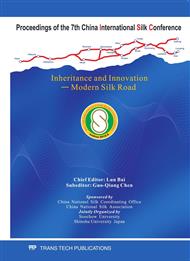p.884
p.890
p.894
p.900
p.906
p.911
p.917
p.923
p.928
Research on Intelligent Clothing Pattern Auxiliary Input and Grading System
Abstract:
Intelligent clothing pattern auxiliary input and grading system which was based on the digital camera input was introduced. Compared with digitizers and scanners, it was much more convenient, flexible and lower cost to photograph patterns using a digital camera. The system could directly transform the pattern’s format from bitmap to vector diagram and rectify the pattern in a geometrical light. At the same time, it combined with the grading method, which was stemmed from the D-value between different sizes, to reduce the grading errors below 5 % and to fully achieve the motherboard precision. Thereby, efficiency and precision in the production of garment pattern input and grading were improved. The system has been well received in the practical application.
Info:
Periodical:
Pages:
906-910
Citation:
Online since:
January 2011
Authors:
Keywords:
Price:
Сopyright:
© 2011 Trans Tech Publications Ltd. All Rights Reserved
Share:
Citation:


